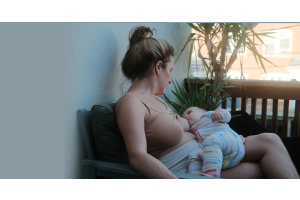If you’re a breastfeeding mum you’ve probably noticed your newborn’s weight dropped a bit then regained afterward. You might be wondering whether you're feeding enough if your baby is having enough milk.
In this article, we will cover the signs of newborn and older babies having enough milk, what you can do to make sure you’re feeding often enough, and how to use the WHO baby growth chart to track your baby’s growth.
Is my newborn having enough breast milk?
For exclusively breastfed newborns, it is not uncommon if your newborn experienced a weight drop (5-7%) during the first week and then regained the weight 10-14 days after birth.
Check these signs to see if the baby is drinking enough:
- Does your baby have wet diapers more than 6 times per day?
- If your bub isn’t urinating enough that probably means the liquid intake was insufficient.
- Does your baby have dirty diapers 4 to 5 times per day?
- Read this article to learn more about the baby’s poop.
- After a nursing session, do your breasts feel soft/ empty?
- Having milk expressed out from your milk duct will make your breasts feel softer.
Is my baby having enough breast milk?
For babies that are beyond newborn (here we refer to babies beyond 6 weeks), assessing whether they are having enough human milk is slightly different.
Check out these signs:
- Does your baby have wet diapers more than 5 times per day?
- If your bub isn’t urinating enough that probably means the liquid intake was insufficient.
- Dirty Diapers frequency really depends on bub to bub. Therefore frequency is not a good enough indicator for having enough milk.
- After a nursing session, do your breasts feel soft/ empty?
- Having milk expressed out from your milk duct will make your breasts feel softer.
I’m trying to feed my baby but I don’t know when she is hungry...
Learning baby’s cues can come in handy for first-time parents taking care of the baby. Interpreting a baby’s body language can help you identify whether your baby is hungry, needing a diaper change, want to sleep, seeking attention, and more.
How to learn baby’s cues? Increase the time you’re spending with her, have more skin-to-skin contact, wear her around in a sling. Gradually you can identify her subtle expressions.
It is also worth noting that you should aim to breastfeed your baby 8-12 times per 24 hours. Having frequent nursing sessions/ pumping means that your milk supply is going to stay at a stable amount and you will experience less engorgement pain. If you have insufficient milk supply, you can introduce supplements and infant formula to catch up the gap.
Growth Pattern
- Breastfed Baby vs Formula-fed Baby
Normally formula-fed babies will gain weight faster than breastfed babies. Therefore, comparing your breastfed baby with a formula-fed baby is unnecessary. - WHO Growth Chart
WHO provided growth charts from Newborn to 24 months of age, tracking the babies’ length, weight, and head circumference. Notice there different growth charts for boys and girls. You can access WHO Growth Chart Printables here, print them out and use them for tracking your baby’s growth.
As always, if you have any questions and concerns don’t hesitate to reach out to your GP to seek professional advice.













Validate your login
Sign In
Create New Account